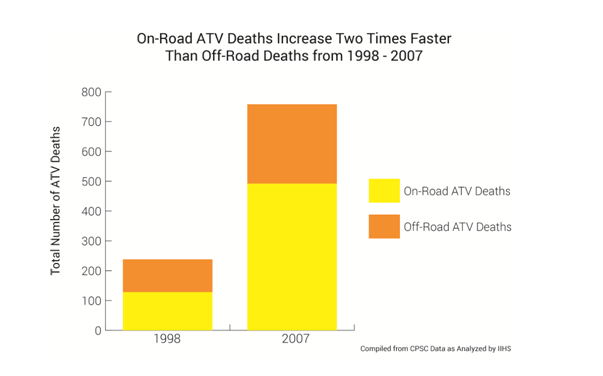Off-Highway Vehicle Safety and Fatality Data
The Consumer Federation of America leads a coalition of individuals and organizations dedicated to reducing deaths and injuries caused by off-highway vehicles (OHVs). OHVs are made up of three main subsets of vehicles: All-Terrain Vehicles (ATVs), Recreational Off-Highway Vehicles (ROVs), and Utility Task Vehicles (UTVs). All of these vehicles carry risks of serious injury and death when not used properly or with the appropriate safety equipment and all of these vehicles could be made safer with a few common sense design changes. CFA’s OHV Safety Coalition (OSC) focuses its work on proper use (specifically keeping OHVs off of roads) and supporting common sense safety requirements in OHV design. The coalition sends letters opposing proposed ordinances, laws and polices that would endanger the public by increasing recreational ATV access to roads, which can be found here. CFA and the OHV Safety Coalition also collect fatality data from news reports, game or natural resource crash investigations, state crash investigations, as well as data from the CPSC, Occupational Safety and Health Administration (OSHA), and National Highway Traffic Safety Administration (NHTSA). CFA data is likely an underestimate of actual fatalities and CFA consistently updates the data as more information is obtained.
Click here for more background on OHVs.
Fatality Statistics
The Consumer Product Safety Commission (CPSC) collects death and injury data related to ATV use but there is a significant time lag in the data—the 2023 report, for instance, was released in May 2024 and the most recent complete data in that report was from 2020. In an effort to present decision makers with the most up to date data the OSC began collecting data in 2013 and now has the most current OHV fatality data we are aware of.
By tracking news reports, coalition members compile an ongoing spreadsheet of OHV fatalities. As of January 2025, we identified 632 OHV fatalities in 2024, comprised mostly of ATV-related incidents.
In 2023, we identified 498 OHV fatalities, comprised mostly of ATVs and UTVs.
Review our 2022 spreadsheet where we identified 419 OHV fatalities, comprised mostly of ATVs and UTVs.
Review our 2021 spreadsheet where we identified 481 OHV fatalities, comprised mostly of ATVs and ROVs.
Review our 2020 spreadsheet where we identified 615 OHV fatalities, comprised mostly of ATVs and ROVs.
Review our 2019 spreadsheet where we identified 626 OHV fatalities, comprised mostly of ATVs and ROVs.
Review our 2018 spreadsheet where we identified 600 fatalities, comprised mostly of ATVs and ROVs.
Review our 2017 spreadsheet where we identified 635 fatalities, comprised mostly of ATVs and ROVs.
Review our 2016 spreadsheet where we identified 679 fatalities, comprised mostly of ATVs and ROVs.
Review our 2015 spreadsheet where we identified 618 fatalities, comprised mostly of ATVs and ROVs.
Review our 2014 spreadsheet where we identified 649 fatalities, comprised mostly of ATVs and ROVs.
Review our 2013 spreadsheet where we identified 575 fatalities, comprised mostly of ATVs and ROVs.
Click here for more OHV Fatality Data
OHVs and Roads
 In spite of warnings from manufacturers, federal agencies, and consumer and safety advocates
In spite of warnings from manufacturers, federal agencies, and consumer and safety advocates
that OHVs are unsafe on roadways, an increasing number of states have passed laws allowing OHVs on public roads, and additional states and counties are currently considering such laws. The majority of ATV deaths (65% in 2007[1]) take place on roads and action is needed to reverse this dangerous trend.
In response to this problem, CFA has brought together a coalition of individuals and organizations dedicated to reducing deaths and injuries caused by OHVs. As part of our efforts to reverse the trend toward increased OHV use on roads, our coalition works together to educate the public and decision makers about the dangers of allowing OHVs on roads.
Download Full Chart of State laws
Click here for more on OHVs on Roads
OHV Safety Regulations
The OSC has been active in supporting the CPSC’s proposed rule for increasing the safety of ROVs as numerous versions of the ROHVA/ANSI voluntary standard have failed to address the:
- Inadequacy of the stability standard;
- Insufficient occupant protection measures;
- Insufficient handling provisions;
- Lack of a maximum speed for these vehicles;
- Inadequacy of measures to ensure seat belt use by occupants in ROVs.
Key elements of the proposed rule are:
- Lateral stability requirements that specify minimum level of rollover resistance for ROVs
- The same test procedures to measure the vehicle handling properties of cars and light trucks should be applicable to ROVs.
- Limits maximum speed of the ROV when operated with occupied front seat belts unbuckled and requires “means to restrict occupant egress and excursion in the shoulder/hip zone.”
A broad coalition from the insurance, public health and product safety and consumer advocacy realms signed on to letters in opposition to bills that would have delayed the CPSC’s ROV rulemaking.
Click here for more on OHV Safety Solutions
[1] Data from the Consumer Product Safety Commission (CPSC) from 2007 (the most recent complete data), as analyzed by the Insurance Institute for Highway Safety (IIHS).


